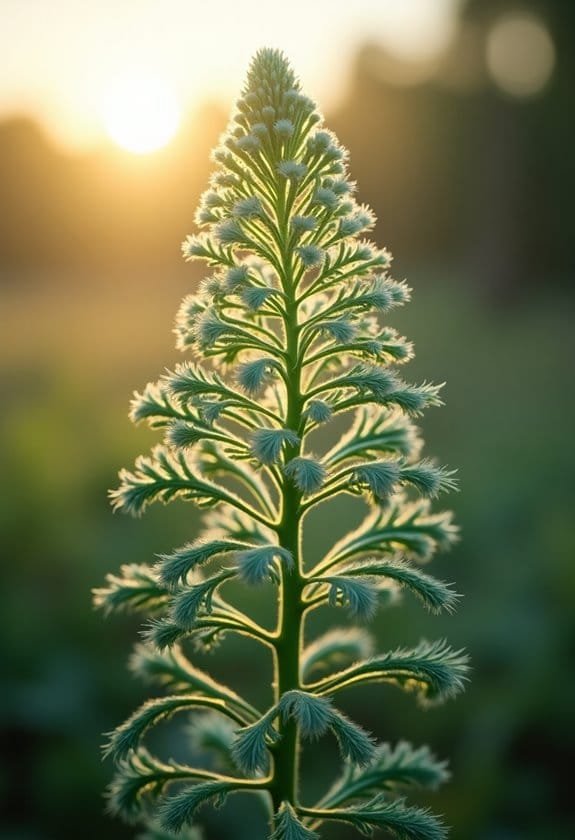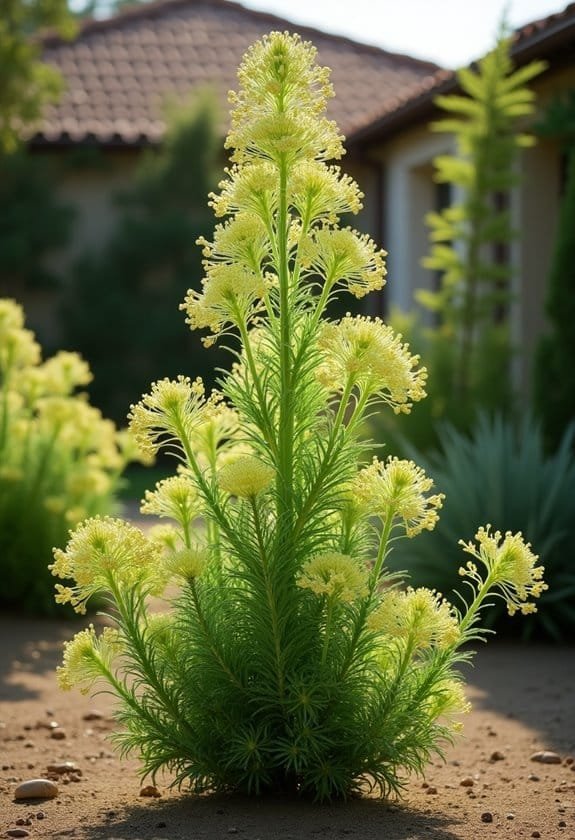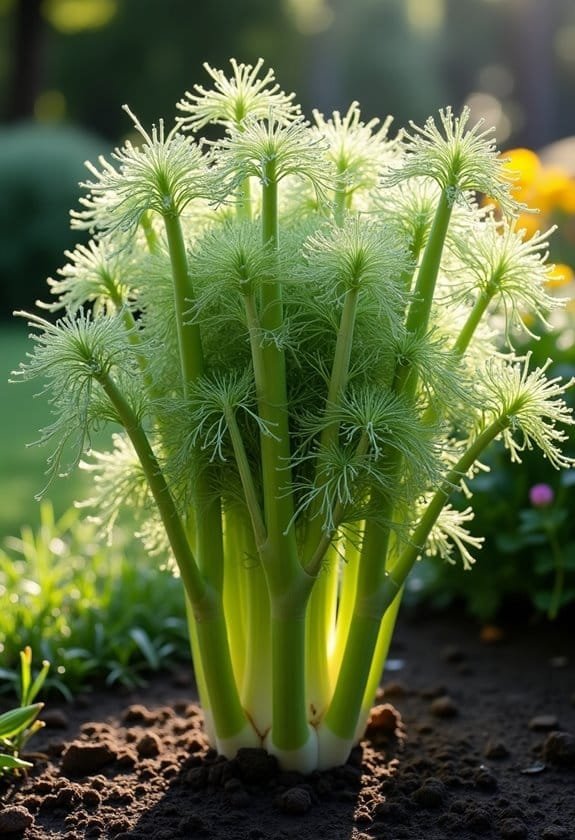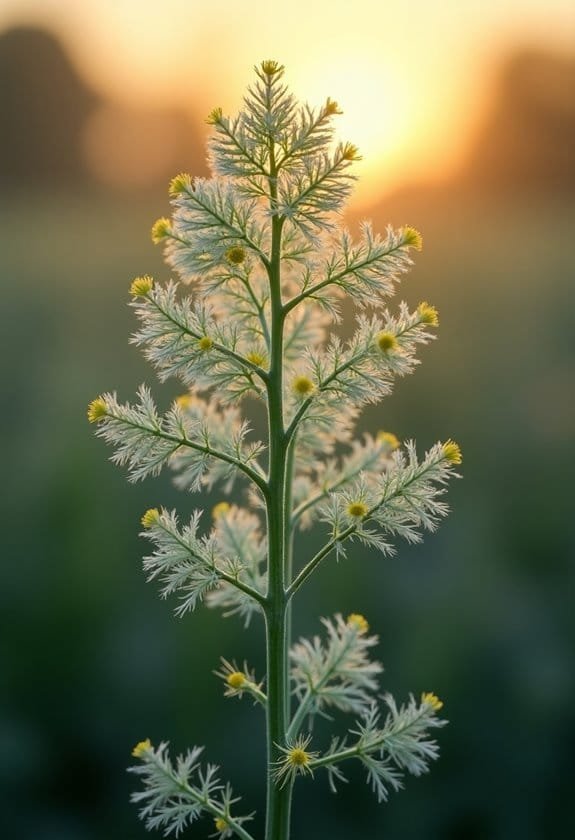Foeniculum vulgare, commonly known as fennel, is a Mediterranean herb that grows up to 6 feet tall with delicate, feathery foliage and bright yellow flower clusters. It's prized for its distinct anise-like flavor and serves as both a culinary herb and pollinator magnet, particularly attracting beneficial insects and swallowtail butterflies. The plant thrives in full sunlight with well-drained soil, requiring 6-8 hours of direct sun daily for ideal flavor development. Its substantial taproot system guarantees resilience, while its bushy structure spans up to 3.25 feet wide. This versatile herb's rich history and multiple uses make it an intriguing specimen for both gardeners and culinary enthusiasts alike.
Main Points
- Foeniculum vulgare is a Mediterranean herb reaching 6 feet tall, featuring feathery foliage and yellow flowers that attract beneficial insects.
- The plant requires full sunlight (6-8 hours daily) and well-drained soil, with a deep taproot system providing stability.
- All parts are edible, including leaves, seeds, and bulbs, offering an anise-like flavor popular in Mediterranean cuisine.
- Flowering occurs from May to September, producing yellow umbel clusters that support pollinators and butterfly populations.
- The plant self-seeds readily and requires management to prevent spreading, particularly in Western Washington where it threatens native plants.
Introduction

Common fennel (Foeniculum vulgare) stands as a versatile Mediterranean herb that has captivated gardeners and cooks for generations with its distinctive anise-like flavor and aromatic properties.
This stately perennial, reaching heights of up to 6 feet, features delicate, feathery foliage and produces clusters of bright yellow flowers that attract beneficial insects to the garden.
Its widespread cultivation spans both culinary and ecological purposes, as the plant provides edible leaves, stems, and seeds while serving as an important host for various butterfly species, particularly the black swallowtail.
Common Name
Known worldwide by several names, Foeniculum vulgare goes by sweet fennel, bronze fennel, finocchio, and Florence fennel. The diversity of its common names reflects both its widespread cultivation and its cultural significance across different regions, particularly in Mediterranean cuisines and traditional medicine.
While Foeniculum vulgare serves as the plant's scientific designation, common fennel has become its most frequently used name in English-speaking countries. This versatile herb's various monikers often highlight its distinct characteristics: "sweet fennel" references its pleasant, anise-like flavor profile, while "bronze fennel" describes certain cultivars with copper-colored foliage.
The Italian name "finocchio" has deep cultural roots, particularly in describing the bulbous form of the plant used extensively in Italian cuisine.
The naming conventions for common fennel demonstrate the plant's remarkable adaptability and widespread adoption across cultures. As it naturalized beyond its Mediterranean origins into Northern Africa, Asia, and North America, local communities developed their own terms for this aromatic herb, though most names continue to reference its distinctive flavoring and culinary applications.
Scientific Name
Scientifically classified as Foeniculum vulgare, fennel belongs to the Apiaceae family alongside carrots, parsley, and dill. This perennial herb's botanical name carries significant historical meaning, with "Foeniculum" derived from the Latin word "faeniculum," meaning "little hay," which aptly describes its aromatic qualities and agricultural heritage.
The species designation "vulgare" indicates its common occurrence throughout its native Mediterranean range, where it has flourished for centuries before spreading globally.
Within the species, notable varieties have emerged, including the common herb type (Foeniculum vulgare) and the specialized Florence fennel (Foeniculum vulgare var. azoricum), which develops a distinctive bulbous base.
The plant's impressive stature, reaching heights of up to 6 feet, combines with its delicate, feathery foliage and characteristic yellow umbel flowers to create an unmistakable botanical profile.
This taxonomic classification reflects not only the plant's physical characteristics but also its relationship to other important culinary and medicinal plants within the Apiaceae family, establishing its significance in both scientific and practical contexts.
Overview
Beyond its scientific classification, Foeniculum vulgare stands as one of the most versatile herbs in Mediterranean culture and modern gardens worldwide. Common fennel captivates gardeners and culinary enthusiasts alike with its towering presence, reaching impressive heights of up to 6 feet, and its distinctive feathery foliage that sways gracefully in summer breezes.
This remarkable herb distinguishes itself through its potent aromatic compounds, which infuse both its delicate leaves and coveted seeds with an unmistakable anise-like flavor. In well-drained soil, the plant develops a robust taproot system that guarantees its survival during dry spells, while its yellow flower umbels serve as essential nectar sources for various pollinators.
The plant's ecological significance extends beyond its culinary applications, as it plays a pivotal role in supporting butterfly populations, particularly the black swallowtail species.
Throughout its growing season from May to September, fennel demonstrates remarkable adaptability, thriving as a perennial in Mediterranean climates while performing admirably as an annual in cooler regions. Its ability to self-seed guarantees consistent presence in gardens, making it a reliable addition to both ornamental and herb gardens.
Key Features
Common fennel stands as a striking herbaceous plant, reaching impressive heights of up to 6 feet with its distinctive, finely dissected dark green foliage.
Its delicate yellow flowers emerge in terminal compound umbels, creating an eye-catching display from May through September that serves as a natural magnet for beneficial pollinators.
The plant's architectural presence is enhanced by its feathery leaves, which contain aromatic oils giving them their characteristic anise-like flavor, making it both an ornamental and culinary garden favorite.
Growth Size
Towering in herb gardens and natural landscapes, fennel (Foeniculum vulgare) reaches impressive heights of up to 6 feet, though it typically grows between 3 to 5 feet tall. The plant's upright, robust growth pattern creates a commanding presence, with its finely dissected dark green foliage extending outward to form a substantial bushy structure that spans 1.5 to 3.25 feet in width.
This architectural herb develops leaves that stretch up to 16 inches in length, featuring delicate, thread-like segments that distinguish it from its cousin, dill, through their distinctly finer texture. Below ground, fennel establishes dominance through its substantial taproot system, which anchors the plant firmly and contributes to its resilient nature.
The plant's towering silhouette is enhanced during the blooming period from May through September, when clusters of tiny yellow flowers form broad, flattened umbels at the stems' crown. These flowering structures add both vertical interest and horizontal dimension to the plant's already impressive stature, creating a striking vertical element in garden compositions.
Appearance
The distinctive silhouette of fennel reveals its most striking features: finely dissected dark green foliage that creates a feathery, cloud-like appearance. Common fennel's triangular leaves divide into delicate, thread-like leaflets that dance in the slightest breeze, resembling the intricate lacework of a master craftsman.
Rising majestically to heights of up to 6 feet, the plant commands attention with its architectural form and sophisticated bearing. The characteristic umbrella-shaped flower clusters, known as umbels, crown the stems with vibrant yellow blooms that persist from late spring through early autumn.
These floral displays serve as beacons for pollinators while adding a splash of color to the garden landscape.
For those seeking additional visual drama, cultivars like Bronze fennel offer a stunning alternative to the traditional dark green variety. Their deep bronze-colored foliage provides a dramatic contrast against other garden plantings, while maintaining the same feathery texture that makes the species so distinctive.
Below ground, a substantial taproot anchors the plant firmly, contributing to its robust, upright stance.
Flowering Season
During its peak flowering period from May through September, fennel transforms into a pollinator's paradise with its distinctive yellow umbels spreading across the uppermost branches.
Common fennel exhibits remarkable floral displays during this season, with each terminal umbel stretching an impressive 5 to 17.5 centimeters in width.
The flowering season represents a vital phase in the plant's life cycle, as these intricate clusters contain between 20 to 50 individual flowers, each contributing to the species' reproductive success.
These delicate yellow blooms serve as important platforms for various pollinators, facilitating cross-pollination throughout the warm months.
The timing of flower emergence typically coincides with ideal environmental conditions, particularly when the plant receives abundant sunlight and grows in well-drained soil.
As the flowering season progresses, these characteristic umbels gradually develop into seed-bearing structures, with each tiny flower potentially producing seeds measuring 3.5 to 4 millimeters in length.
This reproductive phase not only guarantees the plant's propagation but also signals the fennel's robust health and successful adaptation to its growing environment.
Growing Requirements

Common fennel requires full sunlight exposure and thrives in well-drained, relatively poor soils that enhance its distinctive flavor profile.
The plant's temperature tolerance and water requirements shift throughout its growth cycle, with consistent moisture being essential during establishment but becoming less vital once the root system develops.
While fennel adapts to various growing conditions, maintaining proper spacing of 4-6 inches between plants guarantees ideal airflow and reduces competition for nutrients in the soil matrix.
Light
Growing fennel successfully requires full sun exposure, with plants needing 6-8 hours of direct sunlight daily to thrive and develop their signature flavor profile. This Mediterranean herb performs best when grown from seed in locations that receive unobstructed sunlight throughout the growing season.
The intensity and duration of sunlight directly influence fennel's essential oil production, which contributes to its distinctive anise-like flavor and aromatic properties. When planted in partially shaded locations, fennel plants often become leggy and produce less flavorful foliage.
The abundant sunshine not only supports robust growth but also attracts beneficial insects, including butterflies and pollinating bees, which enhance the garden's biodiversity.
During the height of summer, fennel's sun exposure should be monitored to guarantee the soil doesn't dry out completely, as even this drought-tolerant plant benefits from consistent moisture.
In regions with intense afternoon heat, light shade during the hottest hours won't greatly impact the plant's development, though morning sun remains vital for maintaining healthy growth patterns and peak flavor development.
Soil
Well-drained, fertile soil provides the foundation for successful fennel cultivation. The plant's robust root system requires moist, organically enriched conditions that allow for proper nutrient absorption while preventing waterlogging, which can lead to root rot and diminished growth.
Soil fertility plays a particularly nuanced role in fennel development, as excessively rich soils can actually compromise the plant's distinctive flavor profile. Florence fennel varieties, known for their prized bulbous bases, demand especially attentive soil preparation, requiring consistent moisture retention and balanced nutrient levels to achieve ideal bulb formation.
While fennel demonstrates remarkable adaptability across various soil compositions, from clay-based to sandy substrates, its performance peaks in well-drained soil with adequate organic matter content.
Once established, fennel exhibits impressive drought tolerance, though maintaining consistent soil moisture during the critical early growth phases remains essential for healthy development.
Gardeners should focus on creating a balanced growing medium that supports both structural stability and proper water management, ensuring the soil retains enough moisture without becoming waterlogged.
Water
Water management stands at the heart of successful fennel cultivation, requiring a delicate balance between consistent moisture and proper drainage. During its initial growth phase, fennel demands reliably moist soil to develop a robust root system, which serves as the foundation for the plant's long-term health and productivity.
Once fennel has established itself, the plant demonstrates remarkable adaptability to varying moisture conditions, particularly during periods of drought. However, proper irrigation remains essential during the development of Florence fennel's prized bulb, as inadequate moisture can result in smaller, less marketable produce.
While the plant appreciates consistent moisture, overwatering presents a significant risk, potentially leading to root rot and compromised plant health. Like many herbs, fennel's flavor compounds are concentrated when grown in moderately dry, well-drained conditions, as excessive moisture can dilute its characteristic anise-like taste.
Experienced gardeners often follow the principle of maintaining even soil moisture while allowing the top layer to dry slightly between waterings, creating ideal conditions for both plant development and flavor intensity.
Temperature
Throughout its growing season, common fennel demonstrates remarkable adaptability to temperature variations while maintaining specific preferences for ideal growth. The plant flourishes in regions corresponding to USDA hardiness zones 4-9, showcasing its versatility across diverse climate conditions while withstanding light frost during early spring planting.
For best development, fennel thrives when temperatures maintain a steady range between 60°F to 75°F (15°C to 24°C). This temperature sweet spot supports robust growth and flavor development, particularly vital for Florence fennel varieties cultivated for their prized bulbs.
Experienced gardeners typically initiate sowing approximately 2-3 weeks before the final frost date, allowing seedlings to establish themselves as temperatures gradually warm.
While fennel exhibits impressive heat tolerance once established, excessive temperatures can trigger premature bolting and compromise the plant's aromatic qualities. To maximize success, cultivators often schedule plantings to guarantee bulb development occurs during cooler periods, strategically avoiding peak summer heat that might otherwise stress the plants and diminish their culinary potential.
Pollinator Criteria
Common fennel's bright yellow umbels serve as natural beacons for an array of beneficial pollinators, particularly bees and butterflies that frequent the garden during its extended blooming season.
The plant's complex flower structure allows for efficient cross-pollination as insects move between the numerous small blooms within each compound umbel, spreading pollen from one plant to another.
Beyond attracting common pollinators, fennel plays a significant role in supporting Black Swallowtail butterfly populations by providing both nectar for adults and essential foliage for their developing caterpillars.
Attracted Pollinators
Pollinators flock to the bright yellow flowers of fennel, which form large, flattened umbels that serve as natural landing pads. These aromatic fennel plants produce abundant nectar that proves irresistible to a diverse array of beneficial insects, particularly during peak blooming periods.
Among the most notable visitors are black swallowtail butterflies, which have developed a specialized relationship with the plant. These elegant lepidopterans not only gather nectar from the flowers but also rely on fennel as a vital host plant for their offspring. The foliage provides essential sustenance for developing caterpillars, creating a complete lifecycle support system within the garden ecosystem.
Honey bees and native bee species are equally drawn to fennel's nectar-rich blooms, contributing greatly to local pollination networks.
The plant's tendency to self-seed and establish naturalized colonies creates sustainable pollinator habitats that benefit the broader environment. This ecological service extends beyond the immediate vicinity, as increased pollinator activity enhances the reproductive success of neighboring flowering plants, establishing fennel as a cornerstone species in pollinator-friendly landscapes.
Pollination Method
The intricate pollination method of fennel relies heavily on insect-mediated cross-pollination, with its small yellow flowers arranged in distinctive compound umbels that maximize accessibility. These umbrella-shaped flower clusters serve as natural landing platforms, enabling pollinators to move efficiently between individual blooms while collecting nectar and transferring pollen.
During the extended flowering period from May through September, fennel's pollination strategy proves remarkably effective through its structural adaptation. The compound umbels position flowers at various heights and angles, creating an ideal arrangement for diverse pollinator species to access the nectar. This architectural design promotes cross-pollination as insects, particularly bees and butterflies, move methodically from one umbel to another.
The success of fennel's pollination method is evident in its ability to attract and sustain multiple pollinator populations throughout the growing season. As beneficial insects visit the aromatic flowers, they inadvertently facilitate genetic diversity by transferring pollen between different plants.
This systematic approach to pollination not only guarantees the plant's reproduction but also contributes to the broader ecological network by supporting essential pollinator communities.
Care & Maintenance

Common fennel's successful cultivation begins with proper planting in well-drained soil and full sun exposure, with seeds placed ¼ inch deep and seedlings thinned to 4-6 inches apart.
While the plant demonstrates remarkable drought tolerance once established, consistent moisture during its initial growth phase proves essential for developing a robust root system and ideal flavor development.
Gardeners should maintain regular deadheading of spent blooms to prevent aggressive self-seeding, while also considering companion planting strategies that exclude dill and cilantro, which can cross-pollinate with fennel.
Planting Tips
Successful fennel cultivation begins with proper planting techniques and consistent maintenance. For ideal growth, gardeners should sow fennel seeds approximately ¼ inch deep in well-draining soil during early spring, typically 2-3 weeks before the last frost, or in early fall when temperatures remain moderate. The plants require full sun exposure to thrive and develop their characteristic licorice-like flavor.
Proper spacing plays an essential role in fennel's development, as overcrowding can lead to stunted growth and reduced yields. Once seedlings emerge, they should be thinned to maintain 4-6 inches of space between plants, allowing each specimen to develop robust foliage and healthy root systems.
While establishing the plants, consistent moisture is important, though care should be taken to avoid waterlogged conditions that might compromise root health.
To maintain garden aesthetics and prevent unwanted spread, regular deadheading of spent flowers becomes necessary. Gardeners should also monitor their fennel for visiting swallowtail caterpillars, which, while generally beneficial for biodiversity, may require management if their populations grow excessive enough to threaten plant health.
Ongoing Care
Maintaining fennel's importance requires consistent attention to several key aspects of care throughout its growing season. While fennel can be grown with relative ease, proper maintenance guarantees peak flavor development and prevents unwanted spread in the garden.
Regular watering proves essential during the plant's establishment phase, though mature fennel demonstrates impressive drought tolerance. During dry spells, supplemental irrigation helps maintain the characteristic anise-like flavor and prevents stress-induced bolting. Proper spacing of 4-6 inches between plants facilitates adequate air circulation and reduces competition for soil nutrients.
Vigilant maintenance includes removing spent blooms before seed formation occurs, which effectively controls the plant's enthusiastic self-seeding tendencies.
Gardeners should regularly monitor for visiting black swallowtail caterpillars, which naturally gravitate toward fennel's aromatic foliage. While these striking insects can be beneficial for biodiversity, their populations may need management through careful hand removal if defoliation becomes excessive.
The implementation of these care practices not only guarantees robust growth but also maintains the plant's ornamental appeal and culinary value throughout its productive season.
Suggested Companions
Growing fennel alongside carefully selected companion plants can greatly enhance garden productivity and pest management. Common fennel proves particularly beneficial when planted near tomatoes, as it attracts beneficial insects that help protect both species from harmful pests while creating a mutually supportive growing environment.
When planning a companion planting scheme, it's crucial to take into account the specific needs of both fennel and its neighbors. The tall, architectural structure of common fennel creates an excellent backdrop for low-growing herbs like thyme and oregano, while its preference for full sun and well-drained soil makes it compatible with Mediterranean herbs such as basil.
Florence fennel, with its distinct bulbous base, shares similar moisture requirements with lettuce and beets, making them suitable companions in the garden bed.
However, gardeners should avoid planting fennel near carrots, as these plants compete for nutrients and can inhibit each other's growth. Regular maintenance, including the removal of spent flowers, guarantees that fennel remains a cooperative neighbor while preventing aggressive self-seeding that might overwhelm surrounding plants.
Common Issues
While common fennel generally proves resilient against most garden pests, it can become a significant concern when it escapes cultivation and invades natural areas.
The plant's aggressive growth habit and prolific seed production make it particularly troublesome in regions like Western Washington, where it outcompetes native vegetation and disrupts local ecosystems.
Although black swallowtail butterflies may find fennel an attractive host plant, the ecological damage caused by its invasive nature typically outweighs any benefits to individual species.
Pests/Diseases
Throughout its growing season, common fennel proves relatively resistant to pests and diseases, though it can face a few notable challenges. While the plant generally maintains robust health, aphids occasionally colonize the foliage, causing distorted growth patterns and potentially transmitting harmful pathogens.
Notably, not all insects that visit fennel are detrimental; the black swallowtail caterpillar, which feeds on the plant's leaves, actually represents a beneficial relationship in the garden ecosystem.
In terms of diseases, fungal infections pose the most important threat to fennel's wellbeing. Powdery mildew, particularly prevalent in humid conditions, can develop when air circulation is poor or leaves remain wet for extended periods.
The plant's root system may also succumb to rot in waterlogged soils, emphasizing the vital need for well-draining growing conditions. To maintain healthy fennel plants, gardeners should implement regular monitoring practices and consider using organic treatments such as insecticidal soaps or neem oil when necessary.
Proper spacing between plants and careful watering techniques can greatly reduce the likelihood of disease development.
Solutions
The control of common fennel requires a strategic approach depending on the scale of infestation. When fennel can be found in small patches, mechanical control methods like hand-pulling or cutting above-ground growth prove most effective, though the plant's substantial taproot can present challenges.
For larger infestations, a more aggressive strategy may be necessary, often involving targeted herbicide applications as recommended by the PNW Weed Management Handbook. The removal of spent flowers serves as a vital preventive measure, interrupting the plant's reproductive cycle and limiting its spread to neighboring areas.
Long-term management typically demands persistent attention, as successful control often requires repeated cutting over multiple growing seasons to exhaust the plant's resources and prevent reestablishment.
In Western Washington's delicate ecosystems, where common fennel threatens native plant communities, implementing a combination of these control methods has shown promising results.
Property managers should monitor treated areas regularly and be prepared to adjust their control strategies based on the plant's response, ensuring the preservation of native biodiversity.
Summary

Standing proudly in Mediterranean gardens and beyond, common fennel (Foeniculum vulgare) has established itself as a versatile perennial herb prized for both its culinary and ornamental value. This remarkable plant, growing up to 6 feet in height, commands attention with its feathery foliage and clusters of delicate yellow flowers arranged in distinctive umbrella-shaped formations.
In the kitchen, common fennel's leaves, seeds, and young bulbs contribute their characteristic anise-like flavor to numerous dishes, while in the garden, it serves multiple purposes beyond its culinary uses. The plant's ability to attract beneficial insects makes it an excellent companion plant, while simultaneously providing essential habitat for swallowtail butterfly caterpillars.
Though it thrives in well-drained soil and full sunlight, reflecting its Mediterranean origins, fennel's vigorous self-seeding tendency requires careful management to prevent unwanted spread in native ecosystems. Despite this consideration, its remarkable resistance to pests and its architectural presence in the landscape continue to make it a valuable addition to both ornamental and kitchen gardens worldwide.


